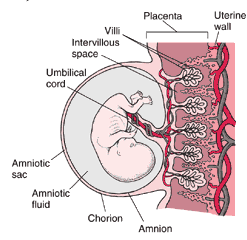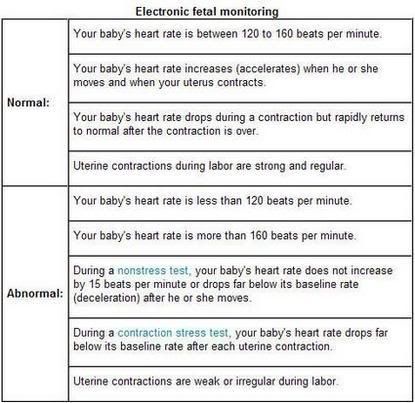A baby goes through several stages of development, beginning as a fertilized egg. The egg develops into a blastocyst, an embryo, then a fetus.
Fertilization
During each normal menstrual cycle, one egg (ovum) is usually released from one of the ovaries, about 14 days before the next menstrual period. Release of the egg is called ovulation. The egg is swept into the funnel-shaped end of one of the fallopian tubes.
At ovulation, the mucus in the cervix becomes more fluid and more elastic, allowing sperm to enter the uterus rapidly. Within 5 minutes, sperm may move from the vagina, through the cervix into the uterus, and to the funnel-shaped end of a fallopian tube—the usual site of fertilization. The cells lining the fallopian tube facilitate fertilization.
If a sperm penetrates the egg, fertilization results. Tiny hairlike cilia lining the fallopian tube propel the fertilized egg (zygote) through the tube toward the uterus. The cells of the zygote divide repeatedly as the zygote moves down the fallopian tube. The zygote enters the uterus in 3 to 5 days. In the uterus, the cells continue to divide, becoming a hollow ball of cells called a blastocyst. If fertilization does not occur, the egg degenerates and passes through the uterus with the next menstrual period.
If more than one egg is released and fertilized, the pregnancy involves more than one fetus, usually two (twins). Such twins are fraternal. Identical twins result when one fertilized egg separates into two embryos after it has begun to divide.
Development of the Blastocyst
Between 5 and 8 days after fertilization, the blastocyst attaches to the lining of the uterus, usually near the top. This process, called implantation, is completed by day 9 or 10.
The wall of the blastocyst is one cell thick except in one area, where it is three to four cells thick. The inner cells in the thickened area develop into the embryo, and the outer cells burrow into the wall of the uterus and develop into the placenta. The placenta produces several hormones that help maintain the pregnancy. For example, the placenta produces human chorionic gonadotropin, which prevents the ovaries from releasing eggs and stimulates the ovaries to produce estrogen and progesterone continuously. The placenta also carries oxygen and nutrients from mother to fetus and waste materials from fetus to mother.
The wall of the blastocyst becomes the outer layer of membranes (chorion) surrounding the embryo. An inner layer of membranes (amnion) develops by about day 10 to 12, forming the amniotic sac. The amniotic sac fills with a clear liquid (amniotic fluid) and expands to envelop the developing embryo, which floats within it.
As the placenta develops, it extends tiny hairlike projections (villi) into the wall of the uterus. The projections branch and rebranch in a complicated treelike arrangement. This arrangement greatly increases the area of contact between the wall of the uterus and the placenta, so that more nutrients and waste materials can be exchanged. The placenta is fully formed by 18 to 20 weeks but continues to grow throughout pregnancy. At delivery, it weighs about 1 pound.
Development of the Embryo
The next stage in development is the embryo, which develops under the lining of the uterus on one side. This stage is characterized by the formation of most internal organs and external body structures. Organ formation begins about 3 weeks after fertilization, when the embryo is first recognizable as having a human shape. Shortly thereafter, the area that will become the brain and spinal cord (neural tube) begins to develop. The heart and major blood vessels begin to develop by about day 16 or 17. The heart begins to pump fluid through blood vessels by day 20, and the first red blood cells appear the next day. Blood vessels continue to develop in the embryo and placenta.
Almost all organs are completely formed by about 8 weeks after fertilization (which equals 10 weeks of pregnancy). The exceptions are the brain and spinal cord, which continue to mature throughout pregnancy. Most malformations occur during the period when organs are forming. During this period, the embryo is most vulnerable to the effects of drugs, radiation, and viruses. Therefore, a pregnant woman should not be given any live-virus vaccinations or take any drugs during this period unless they are considered essential to protect her health (see Drug Use During Pregnancy).
_______________________________________________________
Placenta and Embryo at 8 Weeks
At 8 weeks of pregnancy, the placenta and fetus have been developing for 6 weeks. The placenta forms tiny hairlike projections (villi) that extend into the wall of the uterus. Blood vessels from the embryo, which pass through the umbilical cord to the placenta, develop in the villi. A thin membrane separates the embryo's blood in the villi from the mother's blood that flows through the space surrounding the villi (intervillous space). This arrangement allows materials to be exchanged between the blood of the mother and that of the embryo.
The embryo floats in fluid (amniotic fluid), which is contained in a sac (amniotic sac). The amniotic fluid provides a space in which the embryo can grow freely. The fluid also helps protect the embryo from injury. The amniotic sac is strong and resilient.
__________________________________________________________
Development of the Fetus
At the end of the 8th week after fertilization (10 weeks of pregnancy), the embryo is considered a fetus. During this stage, the structures that have already formed grow and develop. By 12 weeks of pregnancy, the fetus fills the entire uterus. By about 14 weeks, the sex can be identified. Typically, the pregnant woman can feel the fetus moving at about 16 to 20 weeks. Women who have been pregnant before typically feel movements about 2 weeks earlier than women who are pregnant for the first time. By about 23 to 24 weeks, the fetus has a chance of survival outside the uterus.
The lungs continue to mature until near the time of delivery. The brain accumulates new cells throughout pregnancy and the first year of life after birth.




